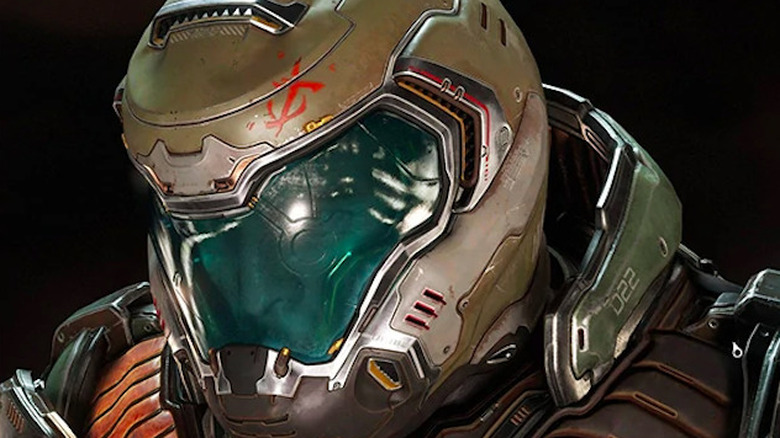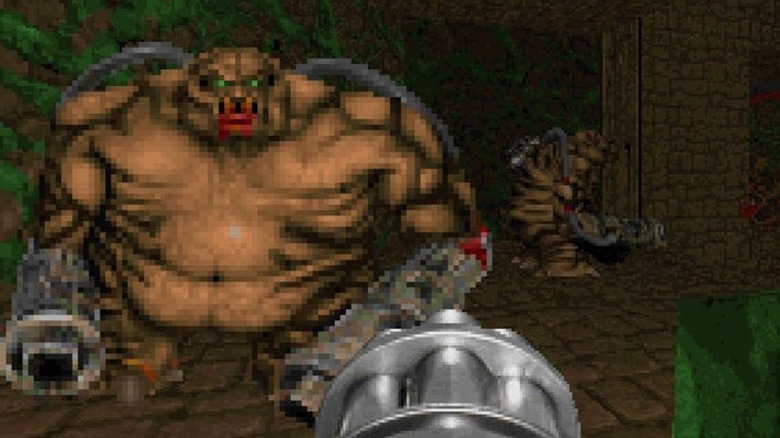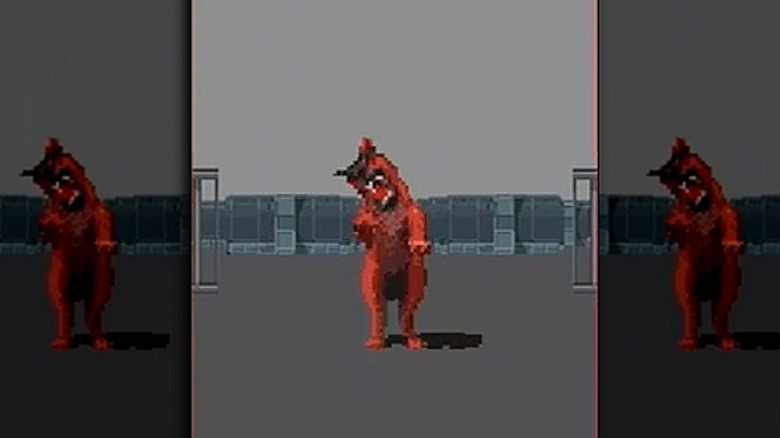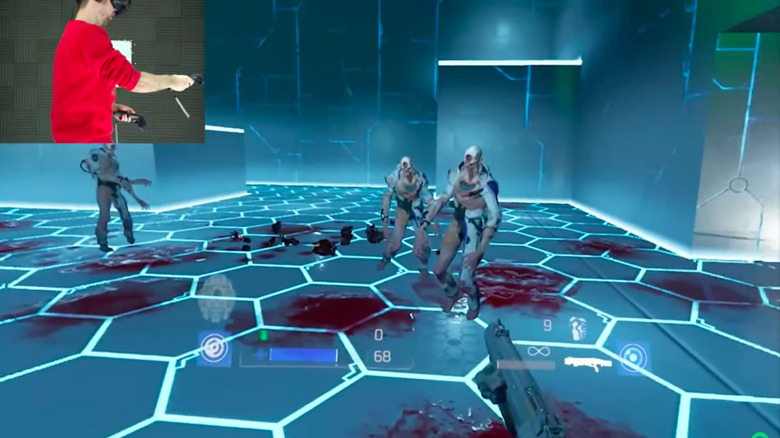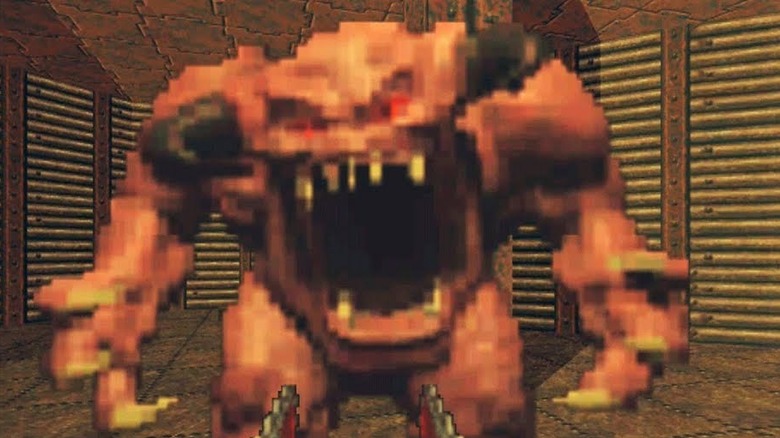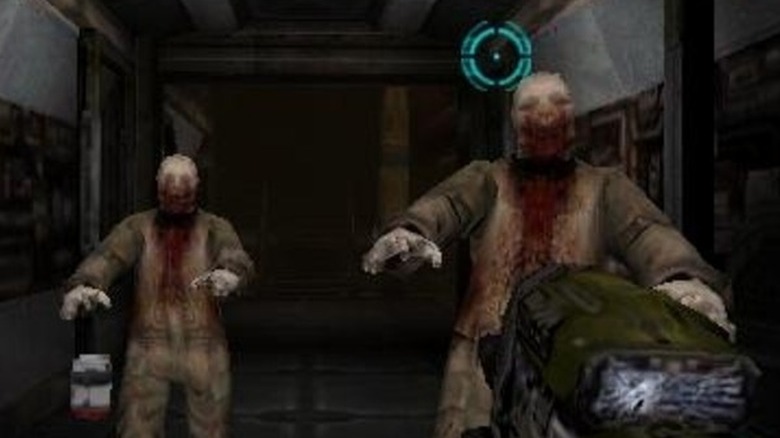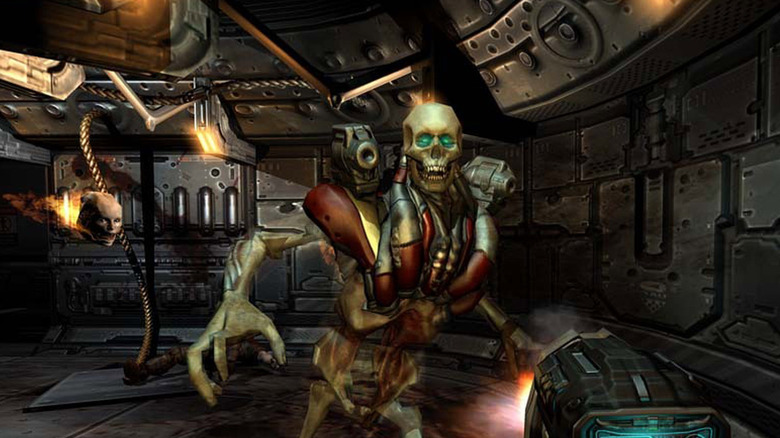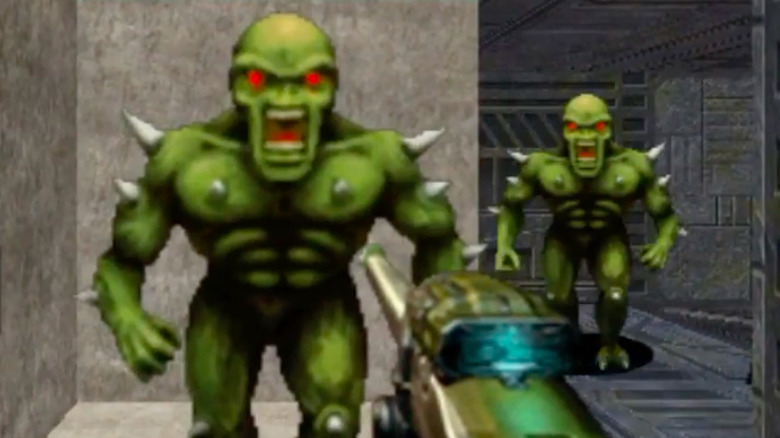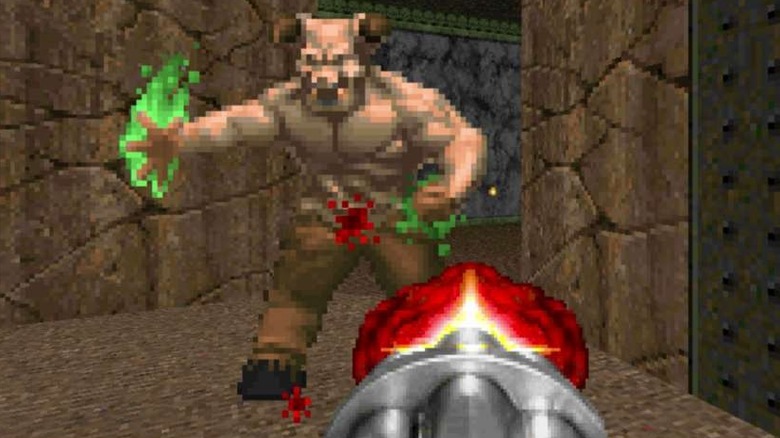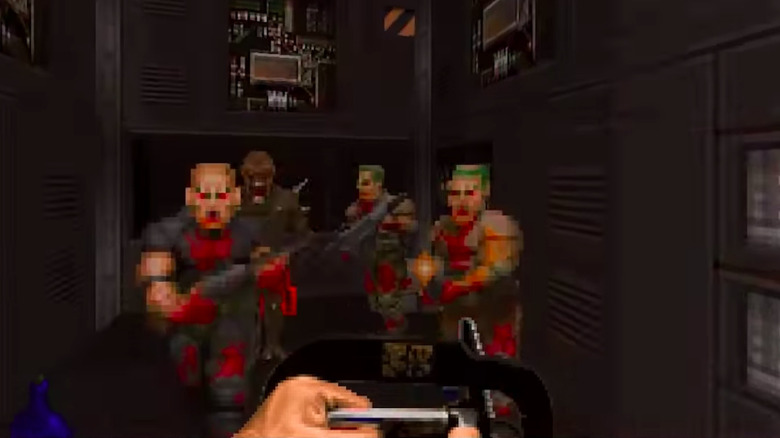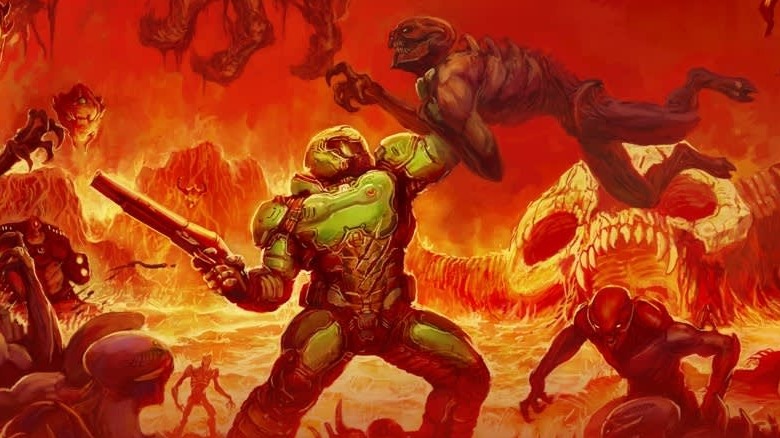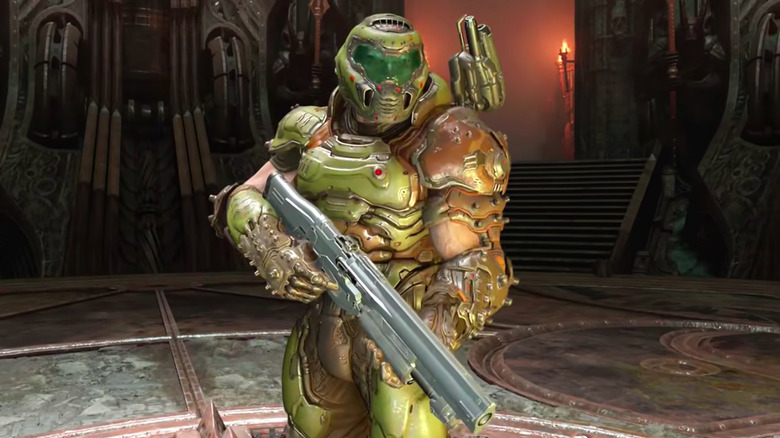Every Doom Game Ranked Worst To Best
"Doom" is an equally famous and infamous franchise. While Doomguy's earliest adventures didn't exactly invent the FPS genre, it did largely define the modern conception of it (to the point that many entries in the genre used to be referred to as "'Doom' clones"). Though the franchise has dipped its toes into more story-heavy campaigns on occasion, "Doom" is known above all else for being a violent, bloody, fast-paced series full of action and demonic destruction, as well as the occasional easter egg.
The popularity of "Doom" has waxed and waned over the years, with some entries gaining major attention and others simply feeling like a rehashing of old concepts. With five main series titles, multiple spin-offs, and countless expansions and mods all revolving around the same basic concept, it's easy to see why fan rankings can be so divisive. Some players like the flashy new titles and their improved mechanics, while others feel like the classics can't be beat.
With all that in mind, it's time to take a look at all the "Doom" games and rank them from worst to best.
11. Final Doom felt like 'more of the same'
The list begins with "Final Doom," which maintains a consistently low ranksing among both critics and fans. The game follows Doomguy through two standalone storylines that take place after the events of "Doom 2." In "TNT: Evilution," the space marine is the sole survivor of an attack on his Jupiter moon base and sets out on a demon-killing spree to avenge their fellow soldiers. "The Plutonia Experiment" takes place during yet another invasion of Earth by the forces of Hell, and tasks the Doomslayer with closing down the final Hellgate and closing the rifts between the dimensions.
"Final Doom" bears a lot of similarities to classic "Doom" and "Doom 2," which is frequently its largest source of criticism. It recycles many of the assets of its predecessors, and the stories' light references to "Doom 2" make the game seem more like an expansion than a standalone product. In a contemporary review for EGM, critic Shawn Smith voiced a complaint shared by many other players: while the level designs were interesting enough, Smith said that "Final Doom" felt like "more of the same," created on an engine that had already begun to feel outdated.
10. Doom RPG changed the pacing
"Doom RPG" is a mobile spin-off that takes place after the first three titles in the series. In this game, players resume the role of the original Doomguy and are tasked with taking down the demons threatening the UAC Mars Outpost. Doomguy must interact with the scientists manning the outposts, working his way through the baddies and betrayals that await him as he searches for a mysterious scientist called Kronos.
While "Doom RPG" greatly resembles its mainline predecessors, it differs significantly in its turn-based gameplay. Since all movement and combat is divided into turns, the action-packed, rip-and-tear pacing of the main series is naturally slowed to a crawl, resulting in a game that's a bit more focused on its plot. While the game did receive some positive reviews from critics and fans, the changes lead to an unfortunate lack of the elements that make the "Doom" series so popular. "Doom RPG" isn't exactly bad, but it ranks near the bottom of the list because there are other, better games in the series.
9. Doom VFR was immersive, but hard to control
"Doom VFR" gives players a whole new level of immersion in the bloody carnage the series is known for. In this VR spin-off, players act as the sole "survivor" of the UAC Martian research facility. After his untimely death, Dr. Abraham Peters has his consciousness uploaded into an artificial matrix with one violent purpose: to do whatever is necessary to drive out the demons and make the facility operational again.
Gameplay is more or less identical to the rest of the "Doom" series, except that the first-person perspective is enhanced with the use of VR. Players control the former doctor on his murder spree as though they were uploaded into the matrix themselves.
The only real drawback comes in the form of the game's difficult and buggy controls. Players have consistently reported very poor stick controls, often having to scrap their VR controllers completely in favor of a more traditional (and less immersive) controller setup. Though the game received generally positive reviews, the controls remained a sticking point in feedback from critics and fans.
8. Doom 64 felt too much like old Doom
Aside from a few improved mechanics and some aesthetic updates, GameSpot noted that the gameplay in "Doom 64" has a very traditional "Doom" feel, as well as a classic "Doom" storyline to accompany it. After the military kills the remainder of the demonic invaders by bombarding Jupiter's moons with radiation, a mysterious entity moves in under their radar and starts bringing the forces of Hell back to life. Doomguy (once again the sole survivor of their unit) must take down the undead demons and the force behind their resurrection.
Truly, the only thing stopping "Doom 64" from ranking higher on this list is the fact that it came out after so many other "Doom" ports and expansions. Although the Nintendo 64 offered some of the best graphics at the time, and the labyrinthian level design was a hit with players, critics felt that the tropes and mechanics in this game had already been done to death. IGN was only one among many to report that even with the updates, "Doom 64" simply felt like yet another "Doom" console port, albeit a better-looking version.
7. Doom Resurrection added some variety to mobile games
"Doom Resurrection" is yet another mobile spin-off, but it goes in a different direction from its RPG siblings. This game is a first-person rail shooter, taking players through a pre-mapped course of demon-killing action as they attempt to rid the UAC Mars facility of the demons who have taken over. Aided by a drone called Sam, players will venture into Hell itself to save the last few survivors of the Mars facility.
"Doom Resurrection" features intuitive motion controls and a straightforward UI, letting players focus on the graphics and the action they came for. The game received pretty positive reviews across the board, though the specific feedback from fans has been a bit split.
A lot of gamers enjoyed "Doom Resurrection," and believed the title was a quality adaptation of the "Doom" franchise in a smaller, more digestible format. Many felt that "Resurrection" managed to retain much of the series' charm while working with the limitations of mobile platforms. Others reported that the game felt repetitive and didn't quite live up to the mainline titles, and that it didn't age well as mobile platforms grew more powerful.
6. Doom 3 was horrifying...ly good
"Doom 3" is a reboot of the series, moving away from the series' classic run-and-gun gameplay in favor of a slower, more story-focused campaign. While attempting to terraform the planet Mars, UAC scientists discover a strange piece of technology left behind by an ancient Martian civilization. Believing it to be a teleportation machine, the scientists activate it, only to realize it opens a portal to Hell. The Doomslayer is sent to the Mars base to uncover what happened to the scientists and to rescue them from the clutches of the demons they ushered in.
Most of the controversy surrounding "Doom 3" revolves around its horror elements. In this sequel, the series' signature high-octane action of the series is replaced with more methodical gameplay, which hasn't sat well with everyone. Pitch-black hallways fill the map, and players must navigate through the darkness with nothing more than a flashlight, until they're forced to fight for their life against the next pocket of demons they uncover.
Some players felt that the game seemed like a clichéd attempt to cash in on the success of other atmospheric horror games. Others liked the creepiness — IGN reported that the game "oozes dread" and that the story was designed to make players feel "that [they're] really and truly alone and in a desperate situation."
5. Doom 2 RPG streamlined turn-based combat
"Doom 2 RPG" takes place one year after the events of the first "Doom RPG." After an invasion takes place on Earth's moon, the three playable protagonists (along with a handful of other UAC soldiers) show up to investigate and put a stop to it. Players work their way through the moon base, Earth, and Hell to fight off the invading demon forces and close the portal between dimensions. Sounds pretty familiar, right?
Gameplay is fairly similar to "Doom RPG," following the same turn-based combat setup. Critical reviews suggest that the game can feel a bit repetitive if you're a fan of the "Doom" franchise; for instance, Pocket Gamer says that the game feels like "an intense and entertaining experience, [but it's not] a new one." Most players, however, seem to feel that the game offers all the same positives as the first RPG, but in a more streamlined package that makes the gameplay feel cleaner and the story more focused.
4. Doom 2 is a replayable phenomenon
"Doom 2: Hell on Earth" is a direct sequel to classic "Doom," and picks up almost immediately where the first game leaves off. Demons have invaded Earth, so the Doomslayer is brought in directly from their previous Hell-razing spree to rescue the remaining survivors and (you guess it) close off the portals threatening the planet.
Aside from ditching the episodic gameplay of the original "Doom," "Doom 2" didn't introduce many changes to the mechanics of the game. Levels grew larger and more intricate and a few new enemies and weapons were brought in, but "Doom 2" ultimately still delivers the same demon-slaying action of its predecessor without too many bells and whistles to weigh it down.
Oddly enough, players appreciate the game both for its lack of change and its potential for it — it's got all the fun of the original "Doom" for players who want more of the classic content, but supports all sorts of mods and extras for anyone looking for a change of pace. Even after all these years, new mods are released regularly, making "Doom 2" an incredibly replayable experience.
3. The original Doom started it all
Nothing beats the classics. "Doom" took the world by storm when it was first released. Fans flocked to the genre-defining FPS in droves, ready to take on the mantle of the unnamed space marine who rips and tears his way through multiple episodes of hardcore demon-slaying. The allure was so great, in fact, that some workplaces had to ban the game to stop the tide of employees logging on during business hours.
The plot is pretty simple, and that's totally fine; most players are here for the gory gameplay. The combination of 3D level design with 2D sprites keeps things simple and fast-paced, allowing players focus on both enemies and environmental hazards without too much hassle. The simplistic design has been the source of some criticism from modern players. In fact, this is a complaint that's persisted even into the recent Nintendo Switch port (alongside a few other critiques about the game not running quite as smoothly as some players might like).
2. The Doom reboot revitalized the franchise
In 2016, the "Doom" franchise underwent yet another reboot with the aptly-named "Doom" (sometimes referred to by fans as "Doom 4" or "NuDoom" for the sake of convenience). In this installment, the Doomslayer is broken out of a sarcophagus prison to deal with a demonic invasion destroying a Martian research facility.
As the first mainline Doom game to be released since "Doom 3," fan expectations were high. Luckily, the game managed to appease both veterans of the series and newcomers alike with high-octane gameplay reminiscent of the classic titles in the series. It moves away from the slow horror trek of "Doom 3" in favor of a good old fashioned bloodbath, and gives players the ability to perform hyper-violent "Glory Kills," which also earn the player a bit of much-needed health restoration.
This return to form was largely successful, with critics like The Telegraph's Sam White praising the game for being particularly "relevant, smart, and self-aware." Fans have enjoyed the speed and challenge provided by the new "Doom," which rewards skill and strategy without excluding newcomers.
Doom Eternal blows its predecessors out of the water
Topping off the list is "Doom Eternal," the latest and greatest entry in the series. It built off the foundation laid out by the 2016 reboot, continuing the story and the slaughter on a whole new level. After Earth is invaded yet again, the Doomslayer descends upon the planet to wreak havoc among the demons threatening the last dregs of humanity. It all culminates in an intense showdown and one of the wildest endings in the series.
The gameplay in "Doom Eternal" is similar to that of 2016's "Doom," but it introduces a handful of new mechanics. In addition to new platforming and puzzle-solving elements, there's also an asymmetrical multiplayer mode where one player (as the Doomslayer) takes on two other players (acting as any of the more powerful demons in the game) in a deathmatch.
The game has performed consistently well with critics. In comparing the game to the beloved "Doom 2," GameRevolution reports that it "[pushes] even further and [creates] one of the best first-person shooters ever made in the process."

